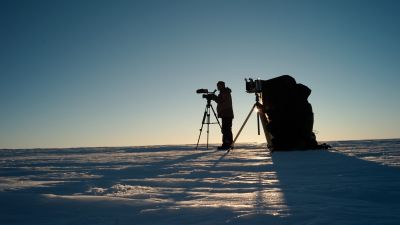
Scientists at Work
Just like Antarctica, the Princess Elisabeth Station is dedicated to science. This year, the station welcomes Irina Gorodetskaya (KULeuven), Steve Roberts (British Antarctic Survey) & Elie Verleyen (UGent) for DELAQUA, and Zorigto Namsaraev (ULg) & Josef Elster (Botany Institute of the Academy of Sciences) for BELDIVA.
-
Irina Gorodetskaya (KUL) on the station's roof with the only microrain radar installed in Antarctica.
© International Polar Foundation / René Robert
-
A wonderful field of cryoconites near the Princess Elisabeth Station.
© International Polar Foundation / René Robert
-
Zorigto Namsaraev is desinfecting the drill to avoid contaminating a cryoconite hole.
© International Polar Foundation / René Robert
-
Drilling into a cryoconite hole.
© International Polar Foundation / René Robert
-
Taking samples from a cryoconite hole.
© International Polar Foundation / René Robert
-
This sediment (cryconite) contains microscopic life.
© International Polar Foundation / René Robert
-
Zorigto Namsaraev (University of Liège) and Josef Elster (Botany Institute of the Czech Academy of Sciences and the University of Southern Bohemia).
© International Polar Foundation / René Robert
-
Calothrix.
© International Polar Foundation / René Robert
-
Coleodesmium.
© International Polar Foundation / René Robert
-
Cyanothece.
© International Polar Foundation / René Robert
-
Nostoc.
© International Polar Foundation / René Robert
-
Phormidium.
© International Polar Foundation / René Robert
-
Steve Roberts (British Antarctic Survey) and Elie Verleyen (UGent).
© International Polar Foundation / René Robert
-
Steve Roberts (BAS) and Elie Verleyen (UGent) with the radar on an ice lake at Utsteinen.
© International Polar Foundation / René Robert
-
Brattnipene.
© International Polar Foundation / René Robert
-
Sampling grid.
© International Polar Foundation / René Robert
-
Photo with satellite positioning.
© International Polar Foundation / René Robert
-
Steve Roberts (British Antarctic Survey) cuts a block of granite on the Brattnipene moraine.
© International Polar Foundation / René Robert
-
Steve Roberts (British Antarctic Survey).
© International Polar Foundation / René Robert
-
Steve Roberts and Elie Verleyn take samples to study in the lab so they can determine the age of the moraines.
© International Polar Foundation / René Robert
-
Using precision GPS to determine the exact location and altitude of a rock.
© International Polar Foundation / René Robert
-
Josef Elster, polar ecologist at Botany Institute of the Czech Academy of Sciences and the University of Southern Bohemia.
© International Polar Foundation / René Robert
-
The bacteria live in these small lakes and in water.
© International Polar Foundation / René Robert
-
Zorigto Namsaraev collects a piece of quartz onto which microscopic fauna has settled.
© International Polar Foundation / René Robert
-
Josef Elster scrapes off samples with a scalpel.
© International Polar Foundation / René Robert
-
Searching for bacteria on a marble strip.
© International Polar Foundation / René Robert
-
Zorigto Namsaraev taking samples.
© International Polar Foundation / René Robert
-
Setting up chambers to study how bacteria respond to a warming of their habitat.
© International Polar Foundation / René Robert
-
An open top chamber. The black spots are bacteria colonies.
© International Polar Foundation / René Robert
-
From left to right, Josef Elster, Elie Verleyen, and Zorigto Namsaraev.
© International Polar Foundation / René Robert






























